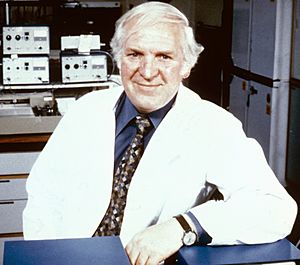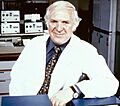James Black facts for kids
Quick facts for kids
James Whyte Black
|
|
|---|---|
 |
|
| Born | 14 June 1924 Uddingston, Lanarkshire, Scotland
|
| Died | 22 March 2010 (aged 85) |
| Nationality | British |
| Citizenship | United Kingdom |
| Alma mater | University College, Dundee |
| Known for | work towards the use of propranolol and cimetidine |
| Awards | Lasker award (1976) Artois-Baillet Latour Health Prize (1979) Wolf Prize in Medecine (1982) Nobel Prize for Medicine (1988) Royal Medal (2004) |
| Scientific career | |
| Fields | Pharmacology |
| Institutions | University of Glasgow ICI Pharmaceuticals University College London King's College London University of St Andrews University of Malaya |
Sir James Whyte Black (June 14, 1924 – March 22, 2010) was a Scottish doctor and scientist who studied how medicines work (a pharmacologist). He made two very important drugs that changed how we treat heart disease and stomach ulcers.
Black became interested in how a natural chemical called adrenaline affects the human heart. This led him to create propranolol, a medicine that helps people with heart problems. He also developed cimetidine, a drug used to treat painful stomach ulcers. For his amazing work in creating these medicines, he won the Nobel Prize in Physiology or Medicine in 1988.
Contents
Early Life and Education
James Black was born in Uddingston, Scotland. He was one of five sons in his family. His father was a mining engineer. James grew up in a place called Fife.
When he was 15, he won a special award called a scholarship. This scholarship allowed him to study medicine at the University of St Andrews. He finished his studies and graduated in 1946. After graduating, he taught at the University of Dundee and later at the University of Malaya. He decided not to become a regular doctor because he wanted to find better ways to help patients.
A Career in Medicine Discovery
After teaching in Singapore for three years, James Black returned to Scotland in 1950. He joined the University of Glasgow. Here, he became very interested in how adrenaline affected the human heart, especially in people with angina (chest pain). He realized that adrenaline did not help these patients.
In 1958, he started working for a company called ICI Pharmaceuticals. He stayed there until 1964. During this time, he created propranolol. This medicine became incredibly popular around the world.
Black also developed a new way to find medicines. Before him, scientists would make new molecules and then test them to see what they could be used for. James Black did the opposite. He would first choose a specific health problem he wanted to solve. Then, he would try to create the right molecules to make a medicine for that problem. The discovery of propranolol was a huge step forward in treating heart disease.
At the same time, Black was also trying to find a treatment for stomach ulcers. Since ICI wasn't interested in this project, he left in 1964. He then joined another company called Smith, Kline and French. He worked there for nine years. During this time, he developed his second major drug, cimetidine. This medicine was first sold in 1975 under the name Tagamet. Tagamet quickly became the world's best-selling prescription drug, even more popular than propranolol!
After his time at Smith, Kline and French, Black continued his important research. He worked at University College London and later at Wellcome Research Laboratories. He also became a professor at King's College London. In 1988, he started the James Black Foundation. Here, he worked with other scientists to research new drugs, including those that might help stop some stomach cancers.
James Black's work greatly improved our understanding of the heart and how medicines affect it. His creation of propranolol is considered one of the most important medical discoveries of the 20th century. His medicines have helped millions of people around the world live healthier lives.
Awards and Recognition
Sir James Black received many honors for his amazing contributions to medicine.
On February 10, 1981, he was made a Knight Bachelor by Queen Elizabeth II. This means he was given the title "Sir" for his services to medical research. On May 26, 2000, the Queen gave him another special honor, appointing him to the Order of Merit.
In 1976, he became a Fellow of the Royal Society, which is a very respected group of scientists. That same year, he won the Lasker award. He also received the Artois-Baillet Latour Health Prize in 1979 and the Wolf Prize in Medicine in 1982.
The biggest award came in 1988 when he won the Nobel Prize in Physiology or Medicine. He shared this prize with two other scientists, Gertrude B. Elion and George H. Hitchings, for their work on developing new drugs. In 1994, he received the Ellison-Cliffe Medal.
- James Black tells his life story at Web of Stories (video)
Images for kids


